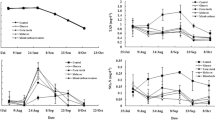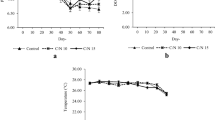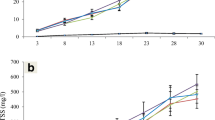Abstract
Effects of different carbon to nitrogen ratios in the biofloc system with sugarcane molasses as organic carbon source on water quality, growth performance, and body composition of common carp (Cyprinus carpio L.) fingerlings were investigated in a 90-day trial. A total of 450 fish (14.17 ± 0.36 g) were fed twice daily with commercial diet at 5% of their body weight under a 12:12 light:dark regime and cultured in 1 control (without extra carbon source) and 4 experimental treatments (C/N: 11:1, 15:1, 19:1, and 23:1) with 3 replicates at a density of 1.06 kg m−3 per tank. Based on the results, the water electrical conductivity (EC) and total dissolved solids (TDS) (measured daily), flocs volume (FV), and total suspended solids (TSS) (measured once a week) were increased from C/N 11:1 to C/N 23:1. The variation patterns of the average levels of total ammonia nitrogen, nitrite, and nitrate (measured once a week) were similar and showed a decreasing trend with an increase in C/N ratio. Total heterotrophic bacteria was also positively affected by increasing C/N to 23:1. The highest fish final weight (59.36 ± 0.24 g), weight gain (45.21 ± 0.47 g), and protein efficiency ratio (PER, 1.77 ± 0.04) were recorded in C/N 19:1. The lowest (1.46 ± 0.03) and highest (1.51 ± 0.05) feed conversion ratio (FCR) and the highest (1.60 ± 0.03%/day) and lowest (1.49 ± 0.01%/day) specific growth rate (SGR) were observed in C/N 19:1 and the control group, respectively (P < 0.05). By increasing the C/N to 23:1, FCR increased and the feed intake, final weight, weight gain, PER, and SGR decreased. The highest crude protein content (77.31 ± 0.43 %DW) and the lowest crude lipid content (12.13 ± 0.32 %DW) of the fish carcass were observed in C/N 19:1 while these values for flocs were not significantly affected by C/N ratio. Overall, the biofloc system with C/N 19:1 improved the water quality and growth performance of common carp while not negatively affecting the carcass proximate analysis.


Similar content being viewed by others
Data availability
The data that support the findings of this study are available on request from the corresponding author. The data are not publicly available due to privacy or ethical restrictions.
References
Ahmad HI, Verma AK, Babitha Rani AM, Rathore G, Saharan N, Gora AH (2016) Growth, non-specific immunity and disease resistance of Labeo rohita against Aeromonas hydrophila in biofloc systems using different carbon sources. Aquaculture 457:61–67
Ahmad HI, Babitha Rani AM, Verma AK, Maqsood M (2017) Biofloc technology: an emerging avenue in aquatic animal healthcare and nutrition. Aquac Int 25:1215–1226
AOAC (2000) Official methods of analysis of AOAC international, 17th edn. Association of Analytical Communities, Gaithersburg
APHA (2005) Standard methods for the examination of water and wastewater, 21st edn. American Public Health Association, Washington
Avnimelech Y (1999) Carbon/nitrogen ratio as a control element in aquaculture systems. Aquaculture 176:227–235
Avnimelech Y (2006) Bio-filters: the need for an new comprehensive approach. Aquac Eng 34:172–178
Avnimelech Y (2007) Feeding with microbial flocs by tilapia in minimal discharge bio-flocs technology ponds. Aquaculture 264:140–147
Avnimelech Y (2009) Biofloc technology – a practical guide book. The World Aquaculture Society, Baton Rouge
Avnimelech Y (2012) Biofloc technology - a practical guide book, 2nd edn. The World Aquaculture Society, Baton Rouge
Avnimelech Y, Kochba M (2009) Evaluation of nitrogen uptake and excretion by tilapia in bio floc tanks, using 15N tracing. Aquaculture 287:163–168
Azim ME, Little DC (2008) The biofloc technology (BFT) in indoor tanks: water quality, biofloc composition, and growth and welfare of Nile tilapia (Oreochromis niloticus). Aquaculture 283:29–35
Bakhshi F, Najdegerami EH, Manaffar R, Tukmechi A, Farah KR (2018) Use of different carbon sources for the biofloc system during the grow-out culture of common carp (Cyprinus carpio L.) fingerlings. Aquaculture 484:259–267
Coyle SD, Bright LA, Wood DR, Neal RS, Tidwell JH (2011) Performance of Pacific white shrimp, Litopenaeus vannamei, reared in zero-exchange tank systems exposed to different light sources and intensities. J World Aquacult Soc 42:687–695
Crab R, Avnimelech Y, Defoirdt T, Bossier P, Verstraete W (2007) Nitrogen removal techniques in aquaculture for a sustainable production. Aquaculture 270:1–14
Crab R, Chielens B, Wille M, Bossier P, Verstraete W (2010) The effect of different carbon sources on the nutritional value of bioflocs, a feed for Macrobrachium rosenbergii postlarvae. Aquac Res 41:559–567
Crab R, Defoirdt T, Bossier P, Verstraete W (2012) Biofloc technology in aquaculture: beneficial effects and future challenges. Aquaculture 356-357:351–356
Craig S, Helfrich LA (2002) Understanding nutrition, feeds and feeding. National Register of Access Consultants, USA, 220–56
Dauda AB, Romano N, Ebrahimi M, Teh JC, Ajadi A, Chong CM, Karim M, Natrah I, Kamarudin MS (2018) Influence of carbon/nitrogen ratios on biofloc production and biochemical composition and subsequent effects on the growth, physiological status and disease resistance of African catfish (Clarias gariepinus) cultured in glycerol-based biofloc systems. Aquaculture 483:120–130
De Schryver P, Crab R, Defoirdt T, Boon N, Verstraete W (2008) The basics of bio-flocs technology: the added value for aquaculture. Aquaculture 277:125–137
De Schryver P, Sinha AK, Kunwar PS, Baruah K, Verstraete W, Boon N, De Boeck G, Bossier P (2010) Poly-beta-hydroxybutyrate (PHB) increases growth performance and intestinal bacterial range-weighted richness in juvenile European sea bass, Dicentrarchus labrax. Appl Microbiol Biotechnol 86:1535–1541
Ebeling JM, Timmons MB, Bisogni JJ (2006) Engineering analysis of the stoichiometry of photoautotrophic, autotrophic, and heterotrophic removal of ammonia–nitrogen in aquaculture systems. Aquaculture 257:346–358
Ekasari J, Crab R, Verstraete W (2010) Primary nutritional content of bio-flocs cultured with different organic carbon sources and salinity. HAYATI J Biosci 17:125–130
Ekasari J, Zairin M Jr, Putri DU, Sari NP, Surawidjaja EH, Bossier P (2015) Biofloc-based reproductive performance of Nile tilapia Oreochromis niloticus L. broodstock. Aquac Res 46:509–512
Ekasari J, Suprayudi MA, Wiyoto W, Hazanah RF, Lenggara GS, Sulistiani R, Alkahfi M, Zairin M (2016) Biofloc technology application in African catfish fingerling production: the effects on the reproductive performance of broodstock and the quality of eggs and larvae. Aquaculture 464:349–356
Emerenciano M, Ballester ELC, Cavalli RO, Wasielesky W (2012) Biofloc technology application as a food source in a limited water exchange nursery system for pink shrimp Farfantepenaeus brasiliensis (Latreille, 1817). Aquac Res 43:447–457
Emerenciano M, Gaxiola G, Cuzon G (2013) Biofloc technology (BFT): a review for aquaculture application and animal food industry. In: Biomass now – cultivation and utilization (ed. by M.D. Matovic). InTech, Queen’s University, Belfast, pp 301–328
FAO (2018) The state of world fisheries and aquaculture 2018 - meeting the sustainable development goals. FAO
Ghasemi Z, Sourinejad I, Kazemian H, Rohani S (2018) Application of zeolites in aquaculture industry: a review. Rev Aquac 10:75–95
Hari B, Madhusoodana KB, Varghese JT, Schrama JW, Verdegem MCJ (2006) The effect of carbohydrate addition on water quality and the nitrogen budget in extensive shrimp culture systems. Aquaculture 252:248–263
Jena JK, Das PC (2006) Carp culture. In: Handbook of fisheries and aquaculture (eds. by Verma SA, Kumar AT & Pradhan S). Indian Council of Agricultural Research, New Delhi, pp 265–282
Khanjani MH, Sajjadi MM, Alizadeh M, Sourinejad I (2016) Study on nursery growth performance of Pacific white shrimp (Litopenaeus vannamei Boone, 1931) under different feeding levels in zero water exchange system. Iran J Fish Sci 15:1465–1484
Khanjani MH, Sajjadi MM, Alizadeh M, Sourinejad I (2017) Nursery performance of Pacific white shrimp (Litopenaeus vannamei Boone, 1931) cultivated in a biofloc system: the effect of adding different carbon sources. Aquac Res 48:1491–1501
Luo G, Gao Q, Wang C, Liu W, Sun D, Li L, Tan H (2014) Growth, digestive activity, welfare, and partial cost-effectiveness of genetically improved farmed tilapia (Oreochromis niloticus) cultured in a recirculating aquaculture system and an indoor biofloc system. Aquaculture 422-423:1–7
Mahanand SS, Moulick S, Rao PS (2013a) Water quality and growth of Rohu, Labeo rohita, in a biofloc system. J Appl Aquac 25:121–131
Mahanand SS, Moulick S, Srinivasa RP (2013b) Optimum formulation of feed for rohu, Labeo rohita (Hamilton), with biofloc as a component. Aquac Int 21:347–360
Mirzakhani N, Ebrahimi E, Jalali SAH, Ekasari J (2019) Growth performance, intestinal morphology and nonspecific immunity response of Nile tilapia (Oreochromis niloticus) fry cultured in biofloc systems with different carbon sources and input C:N ratios. Aquaculture 512:734235
Najdegerami EH, Bakhshi F, Lakani FB (2016) Effects of biofloc on growth performance, digestive enzyme activities and liver histology of common carp (Cyprinus carpio L.) fingerlings in zero-water exchange system. Fish Physiol Biochem 42:457–465
Noga EJ (2000) Fish disease, diagnosis and treatment. Lowastate university Press, Iowa
Panigrahi A, Sundaram M, Chakrapani S, Rajasekar S, Syama DJ, Chavali G (2019) Effect of carbon and nitrogen ratio (C:N) manipulation on the production performance and immunity of Pacific white shrimp Litopenaeus vannamei (Boone, 1931) in a biofloc-based rearing system. Aquac Res 50:29–41
Pérez-Fuentes JA, Hernández-Vergara MP, Pérez-Rostro CI, Fogel I (2016) C:N ratios affect nitrogen removal and production of Nile tilapia Oreochromis niloticus raised in a biofloc system under high density cultivation. Aquaculture 452:247–251
Piedrahita RH (2003) Reducing the potential environmental impact of tank aquaculture effluents through intensification and recirculation. Aquaculture 226:35–44
Ray AJ, Dillon KS, Lotz JM (2011) Water quality dynamics and shrimp (Litopenaeus vannamei) production in intensive, mesohaline culture systems with two levels of biofloc management. Aquac Eng 45:127–136
Schneider O, Sereti V, Eding EH, Verreth JAJ (2006) Molasses as C source for heterotrophic bacteria production on solid fish waste. Aquaculture 261:1239–1248
Schrader KK, Green BW, Perschbacher PW (2011) Development of phytoplankton communities and common off-flavors in a biofloc technology system used for the culture of channel catfish (Ictalurus punctatus). Aquac Eng 45:118–126
Wang G, Yu E, Xie J, Yu D, Li Z, Luo W, Qiu L, Zheng Z (2015) Effect of C/N ratio on water quality in zero-water exchange tanks and the biofloc supplementation in feed on the growth performance of crucian carp, Carassius auratus. Aquaculture 443:98–104
Wei YF, Liao SA, Wang AL (2016) The effect of different carbon sources on the nutritional composition, microbial community and structure of bioflocs. Aquaculture 465:88–93
Xu WJ, Pan LQ (2012) Effects of bioflocs on growth performance, digestive enzyme activity and body composition of juvenile Litopenaeus vannamei in zero-water exchange tanks manipulating C/N ratio in feed. Aquaculture 356-357:147–152
Zhang N, Luo G, Tan H, Liu W, Hou Z (2016) Growth, digestive enzyme activity and welfare of tilapia (Oreochromis niloticus) reared in a biofloc-based system with poly-β-hydroxybutyric as a carbon source. Aquaculture 464:710–717
Zhao Z, Xu Q, Luo L, Wang Ca, Li J, Wang L (2014) Effect of feed C/N ratio promoted bioflocs on water quality and production performance of bottom and filter feeder carp in minimum-water exchanged pond polyculture system. Aquaculture 434:442–448
Acknowledgments
The authors gratefully acknowledge Azadegan fish farming complex for providing the fish and culture facilities.
Author information
Authors and Affiliations
Contributions
Khalil Minabi performed the experiments. Iman Sourinejad was the supervisor and designed the experiments. Morteza Alizadeh was the adviser and helped the data analysis. Ebrahim Rajabzadeh Ghatrami was the adviser and helped with the field operations. Mohammad Hossein Khanjani contributed to the data analysis and helped with the manuscript preparation.
Corresponding author
Ethics declarations
Conflict of interest
The authors declare that they have no conflicts of interest.
Ethics statement
The authors confirm the experimental protocols were approved by Iranian Fisheries Research Organization, and that all experiments were performed in accordance with relevant guidelines and regulations.
Additional information
Publisher’s note
Springer Nature remains neutral with regard to jurisdictional claims in published maps and institutional affiliations.
Rights and permissions
About this article
Cite this article
Minabi, K., Sourinejad, I., Alizadeh, M. et al. Effects of different carbon to nitrogen ratios in the biofloc system on water quality, growth, and body composition of common carp (Cyprinus carpio L.) fingerlings. Aquacult Int 28, 1883–1898 (2020). https://doi.org/10.1007/s10499-020-00564-7
Received:
Accepted:
Published:
Issue Date:
DOI: https://doi.org/10.1007/s10499-020-00564-7




